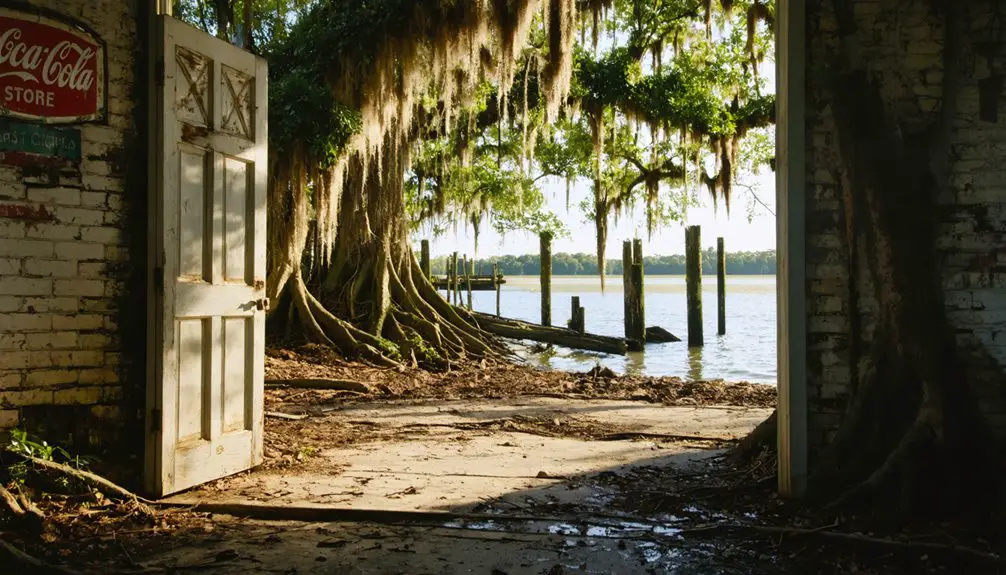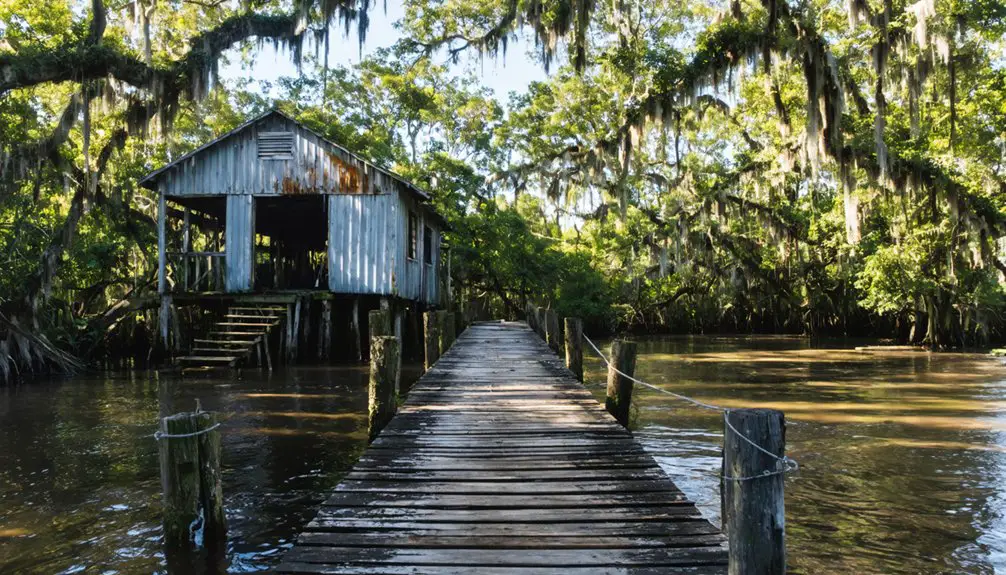You’ll find East Goose Creek‘s remains along Wakulla Beach Road, where Henry and Daisy Walker’s 1915 coastal dream once flourished. Their vision included a grand hotel, tourism amenities, and a thriving waterfront community that balanced industry with leisure. Today, this ghost town‘s boarded-up structures and weathered remnants tell a story of ambitious coastal development cut short by natural forces, leaving behind a fascinating piece of Florida’s early 20th-century history that beckons further exploration.
Key Takeaways
- East Goose Creek was established in 1915 as a coastal tourist destination by Henry and Daisy Walker along Wakulla Beach.
- The town centered around Wakulla Beach Hotel and combined tourism with working industries like lumber mills and turpentine camps.
- Rich fishing culture and natural bird populations made the area attractive for both recreation and commercial purposes.
- Today, the abandoned town shows extensive decay from hurricanes, floods, and salt air, with only boarded-up structures remaining.
- The ghost town’s layout and street names preserve the legacy of early 1900s Florida coastal development ambitions.
The Birth of a Coastal Dream (1915)

Three visionaries – Florida State Senator Henry N. Walker Sr., his wife Daisy, and the raw beauty of Wakulla Beach – converged in 1915 to birth East Goose Creek.
You’ll find their ambitious dream took shape as a coastal tourist destination, complete with a strategically designed hotel that captured invigorating sea breezes through its long porch, sleeping rooms, and dining area.
The Walkers’ vision extended beyond mere buildings. They chose a site where ecological observations revealed thriving bird populations, creating a natural paradise for visitors.
The Walkers envisioned more than vacation lodging – they selected land where abundant wildlife created nature’s own resort destination.
The town’s formal layout centered around hospitality facilities, marking one of Florida’s early attempts at coastal tourism development.
In this pristine setting, the founders aimed to blend environmental appreciation with leisure pursuits, establishing a unique retreat along Florida’s untamed coastline.
Political Influence and Town Planning
While Senator Henry N. Walker and his wife Daisy wielded significant political influence to establish East Goose Creek as a resort destination in 1915, you’ll find their vision was part of a deeper historical pattern.
Political factions like the “Goose Creek Men” had already shaped regional dynamics through their involvement in territorial expansion and colonial conflicts. The Walkers’ development ambitions, anchored by the Wakulla Beach Hotel project, reflected this legacy of political leverage in land development. These political maneuvers echoed the tactics of impecunious planter James Moore, who rose to power through strategic connections and Indian trade.
You’ll see how modern planning evolved through careful zoning changes, shifting from conservation areas to residential spaces while balancing growth with environmental concerns.
The town’s development faced layered regulatory oversight, requiring detailed attention to drainage, parking, and fire access – a stark contrast to the more forceful political maneuvers of colonial times.
Life Along Wakulla Beach Road
Since its establishment in 1915, Wakulla Beach Road – originally called Hotel Avenue – served as the main artery of East Goose Creek’s brief but vibrant existence.
You’d have found a bustling mix of activities along this coastal thoroughfare, where tourism history intertwined with working-class industry. The Wakulla Beach Hotel welcomed visitors seeking seaside leisure, while nearby lumber mills and turpentine camps hummed with activity.
Where leisure meets industry – oceanfront hotels and weekend tourists mingling with the sawdust and sweat of mill workers.
The area’s rich fishing culture drew anglers to Goose Creek Bay, where steam yachts like the “Joker” plied the waters. Much like the Paleo-Indian artifacts discovered nearby, these waters held evidence of human presence dating back thousands of years. Archaeological studies suggest human inhabitants first arrived in the region around 14,500 years ago.
You could’ve spotted Native American archaeological sites near the beach, proof of centuries of human habitation.
The road connected you to both work and play – from the sawdust piles of logging operations to the invigorating waters where swimmers and paddlers found refuge.
What Remains Today
Today, the once-lively stretch of Wakulla Beach Road stands in stark contrast to its bustling past.
You’ll find decay patterns that tell stories of nature’s relentless assault – hurricanes, floods, and corrosive salt air have transformed vibrant structures into weathered shells. Similar to Stiltsville’s remaining structures, these buildings have endured decades of devastating storms.
Community nostalgia runs deep as locals debate the site’s future between preservation and redevelopment. The area has remained in this deteriorated state since the 1970s, impacting surrounding property values.
- Only a handful of boarded-up homes and stores remain standing
- Abandoned buildings show extensive water damage and mold growth
- Scattered furniture hints at occasional squatter activity
- Storm damage and flooding have left lasting structural impacts
- Development plans face resistance from preservation-minded residents
The ghost town’s isolation persists, with restricted access and minimal preservation efforts.
While developers eye the waterfront location for mixed-use projects, the site continues its slow surrender to the elements, caught between progress and remembrance.
Legacy of a Lost Community

Although East Goose Creek‘s physical structures have crumbled, its legacy endures as a monument to Florida’s ambitious coastal development era of the early 1900s.
Similar to the Hampton Springs Hotel that once attracted visitors with its luxurious amenities, you’ll find the town’s historical significance woven into the story of Senator Henry Walker and his wife Daisy, who envisioned a thriving beach community that would attract residents from as far as Chicago. Like nearby military training centers, the area once bustled with activity and strategic importance.
The community aspirations of East Goose Creek mirror countless other Florida towns that emerged during this period of growth and opportunity.
While the town didn’t fulfill its original promise, it serves as a compelling reminder of coastal Florida’s development patterns.
Through its preserved street names and documented layout, East Goose Creek continues to tell the story of hope, ambition, and the ever-changing nature of Florida’s coastal landscapes.
Frequently Asked Questions
Were There Any Natural Disasters That Contributed to East Goose Creek’s Abandonment?
You can’t definitively link hurricane impact or flooding events to East Goose Creek’s abandonment, though regional storms likely affected the area. Historical records don’t identify specific natural disasters as abandonment causes.
What Was the Highest Recorded Population of East Goose Creek?
You won’t find any documented highest population records for this ghost town in historical sources. While it was platted in 1915 with defined streets, no reliable population figures exist.
Did Any Businesses or Industries Operate in East Goose Creek?
Despite limited business diversity, you’d find a tourist hotel built in 1915 and West Goose Creek Seineyard operating until 1985’s Hurricane Kate. These represented the main enterprises before industrial decline overtook the area.
Was East Goose Creek Connected to Other Towns by Railroad?
You won’t find evidence of railroad history connecting East Goose Creek to other towns – despite Florida East Coast Railway’s expansion nearby, the remote location lacked direct rail town connections.
Are There Any Photographs of East Goose Creek During Its Active Years?
You won’t find any known photographs from East Goose Creek’s active period through archival research. While historic imagery might exist in private collections, no publicly available photos document the town’s operational years.
References
- https://www.youtube.com/watch?v=pjRdqRH_rHw
- https://www.ghosttowns.com/states/fl/eastgoosecreek.html
- https://en.wikipedia.org/wiki/List_of_ghost_towns_in_Florida
- https://stmarksrefuge.org/wp-content/uploads/st-marks-wakulla-beach-seineyard-2019-1.pdf
- http://www.shrimpnfishflorida.com/forums/threads/lake-county-fl-ghost-towns.5641/
- https://npshistory.com/brochures/nwr/st-marks-wakulla-beach-seineyard-2019.pdf
- https://crtpa.org/wp-content/uploads/Part-IV-CC2ST-Master-Plan-Final-Report-Stories.pdf
- https://digitalcommons.usf.edu/cgi/viewcontent.cgi?article=2782&context=wilson_bulletin
- https://digitalcommons.usf.edu/cgi/viewcontent.cgi?article=2769&context=wilson_bulletin
- https://www.goosecreeksc.gov/sites/default/files/PIO/GooseCreekCP_FINAL_05.11.2021_low-res.pdf



